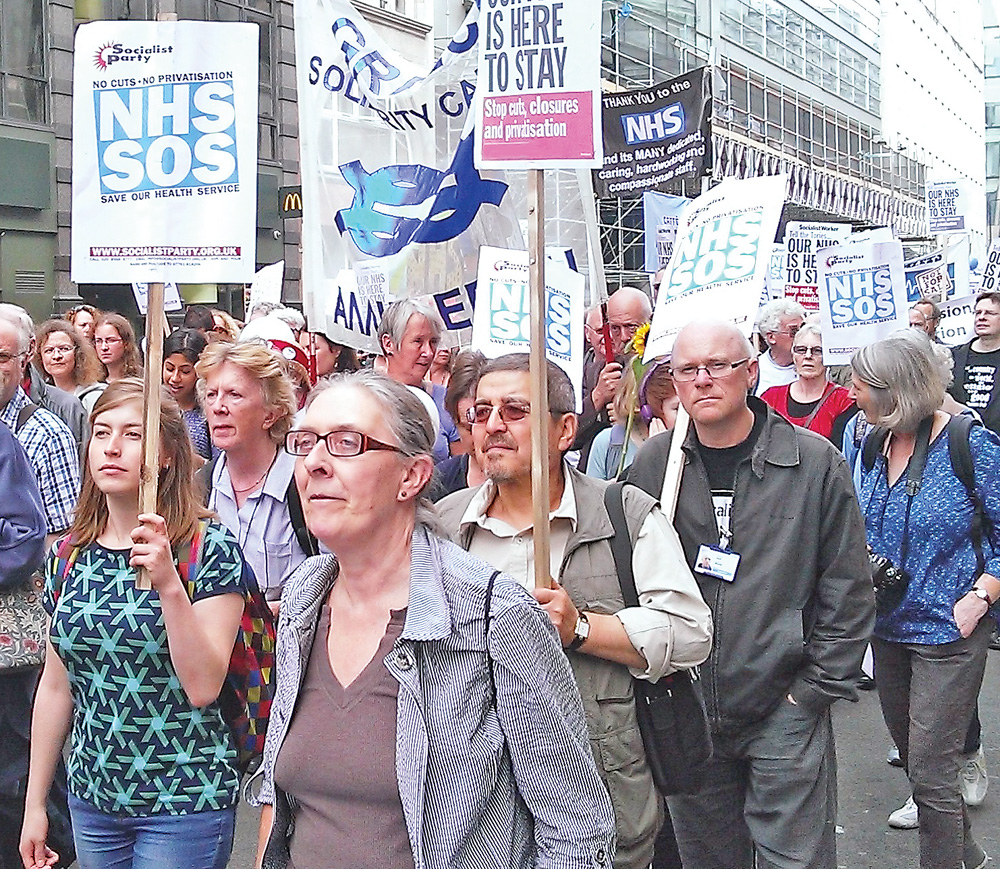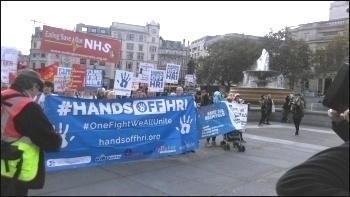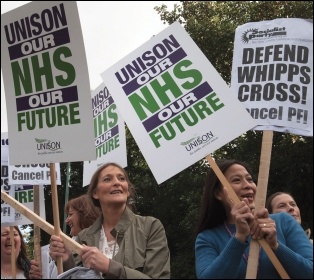Mike Forster, Chair of Hands Off HRI (Huddersfield Royal Infirmary) and steering committee of Health Campaigns Together (personal capacity)
The last 12 months have been the worst in the history of the NHS. It’s under pressure like never before. The crisis moment many warned of has arrived. According to Dr Stokes Lampard, chair of the Royal College of GPs, the NHS is facing a ‘tipping point’.
Accident and Emergency departments (A&Es) represent an early warning sign that the health service is under pressure. Currently, England’s major A&Es are under record strain with ‘black alerts’ being regularly sounded, and in some instances wards turning patients away.
According to the London Evening Standard, 6,000 patients are being left in the back of ambulances every week and there has been a 30% increase in patients being diverted from A&Es due to a lack of beds.
The Ambulance Service too is under severe strain with an average of 1,000 more calls a week compared to just last year. Consequently, ambulance response times have reached critically low levels, with one third of ambulances failing to meet their targets for life threatening callouts.
Chronic underfunding
The acute care sector is bulging with admissions, particularly from over-75s who are presenting themselves at A&Es. Many should be cared for by the social care sector but that has suffered over £5 billion of cuts since 2009-10.
Massive funding cuts in council services means patients are not being discharged in good time from hospital – either into long-term care or back to their own homes under a care package.
According to the British Medical Association (BMA), patients are spending an extra 200,000 days in hospital beds they no longer need, an increase of 25% on last year!
In the Autumn Statement, Chancellor Philip Hammond was lobbied hard for new funding but came up with nothing. Since then the government has promised councils they can raise council tax by 2% to meet the extra demand, which will not even touch the problem. The BMA has described the additional funding as “inadequate”.
There has been a 28% increase in the number of people waiting for emergency treatment in our A&Es for more than the four hours maximum waiting time.
Chronic delays in treatment have also increased the risk of infection in our hospitals, with cases of novovirus in hospitals now at a five-year high.
Despite placid assurances from the government that they are investing in the NHS, the reality on the ground is completely different. NHS funding has been slashed and next year will see NHS spending increase by just 1%, a massive real term cut.
Yet the Department of Health likes to tell us it is about to spend a lot more money on the NHS. Often headlining the same funds over and over again – which seemingly never actually arrive.
Responding to the government’s ten-year budget forecast in 2015, the King’s Fund stated: “The ten years up to 2020-21 are likely to see the largest sustained fall in NHS spending as a share of GDP in any period since 1951.”
This funding crisis is being realised in both community and social care provision. In the community, general practice is on life support. As more is demanded of it, the proportion of the NHS budget that goes to primary care has effectively shrunk.
Primary care provides 90% of the consultations in the NHS yet only gets 8% of the budget. GPs are leaving, and new entrants are declining to enter general practice.
Chronic underfunding has led to cutting more than 13,000 beds, reducing the capacity of the NHS by five million a year.
The NHS crisis has reached parliament with some Tory MPs breaking ranks to chastise the government for the looming crisis.
Dr Sarah Wollaston, Tory chair of the Commons Health Select Committee, has demanded additional funding for the NHS and social care in particular. She has warned Theresa May that she has “immediate concerns” for the future of the NHS. Yet when the head of NHS England, Simon Stevens, went to see her at the end of the year, he was told to find budgetary cuts in the NHS.
There is a looming crisis for the Tories as more MPs come under pressure from local campaign groups around cuts and closures to hospitals and A&Es.
Private vultures
As the health service’s budget faces greater pressure than before, the private sector has moved in for the kill. Last year, £13 billion of healthcare was purchased from non-NHS providers, a 76% increase since 2010. Given that the private sector has a stated goal to make 8%-14% profits from the NHS, can the public really afford this ‘choice’?
While the NHS has increased the cash it earns from the private sector by 30% to £558 million last year, waiting lists have soared to an eight-year high. Four million patients are on waiting lists. In effect, NHS patients are being delayed treatment to make way for private patients who can afford to skip the queue.
Under the 2012 Health and Social Care Act, the government’s duty to provide healthcare was reduced to that of merely commissioning care. This has opened up the health service to further privatisation.
In November 2016, it was announced that Richard Branson’s Virgin Care group had won a £700 million, seven-year contract. This is to provide adult social care, continuing healthcare and children’s community health services for the Bath and North East Somerset NHS Clinical Commissioning Group.
Said to be the largest privatisation yet in the NHS, Virgin Care will oversee 200 social service and healthcare facilities. The group was awarded a £126 million contract to run hospitals in Kent earlier in 2016.
Health workers
Morale among health workers has never been lower. Nurses have seen real-term pay cuts since 2010 of over £2,000. Moreover, aspiring nurses will also be denied a bursary to train – this at a time when unfilled nursing vacancies have climbed 600% since 2010. Applications for trainee nursing courses have fallen 20% this year.
The same can be said for junior doctors where the pressure remains intense since the enforcement of a new contract which has included real-term pay cuts.
The introduction of the STP programme will lead to an acceleration of hospital cuts and closures. However, several councils, to their credit, have refused to sign off on their STP ‘footprint’.
Demonstrate
The NHS is now at the crossroads. If we don’t stand and fight, it could all be lost. Fortunately, the fight back has begun with community groups like ours spreading all over the country.
The umbrella group ‘Health Campaigns Together’ has called a national demonstration on Saturday 4 March in London. This couldn’t come at a better time and will attract thousands. Already Unite, PCS, Napo, and BFAWU unions along with junior doctors, are backing the demo – as is the National Shop Stewards Network, People’s Assembly, Momentum and the National Pensioners Convention.
To its shame the leadership of Unison, the largest health union, has procrastinated and failed to come out in support. We must keep up the pressure to change their minds. Already Unison’s North West and South Eastern regions have announced their support.
The demo must be a springboard for coordinated community, trade union and political action to save and properly fund the NHS. Vulnerable to a huge split around Brexit, the Tories are equally as likely to cave in on extra funding for the NHS as they come under more pressure.
Save our NHS demo
- Saturday 4 March – 12noon, Tavistock Square, London WC1H 9EZ, called by Health Campaigns Together
The Socialist Party will continue to play its part in building for this demonstration and for a fighting programme to build and protect our NHS:
- For a massive demonstration on 4 March
- For a fully funded, public NHS
- No to cuts. Scrap PFI and all privatisation schemes
- Stop STPs and demand all councils refuse to sign up
- For coordinated trade union action to save the NHS and for decent staff pay and conditions
- Nationalise the profiteering big drugs companies










